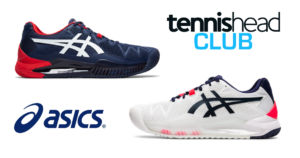
Where to stand in doubles – “Position is key” advises world’s leading strategy expert
In doubles each player usually stands in ‘their own half’ to start a point, left and right, but beyond that simple foundation, there are various positional variations which can be used to influence the outcome of the point.
Tennishead talked to the world’s foremost strategy analyst, Craig O’Shannessy of Brain Game Tennis, for more guidance on how different starting positions in doubles can really help you perform better.
“Where you start really matters,” emphasises O’Shannessy.
Doubles teams often lose the point before it starts from poor positioning alone. Looking at where a player stands to begin a point tells a lot about their speed, intentions and hunger for the ball.
Server
- Generally stands wider than in singles since they have a partner covering the opposite half of the court.
Returner
Wants to factor in:
- How wide the server is standing to serve.
- What groundstroke they want to return with.
- What is the likelihood that the net player is going to get involved.
Server’s partner
- Best set up right in the middle of the service box.
- Can cover half the doubles alley and still access the Centre Window.
Returner’s partner
- Ideally right behind the service line in a neutral position.
- See how the point develops and choose to go forward on offence or back on defence
Starting positions
Below is a diagram of the fundamental starting position in doubles.

As the point progresses, there are a number of variations in how to position yourself on court and in relation to your partner.
One up, One back
- Generally the back player is trying to outrally the opposing team.
OR
- Probing to find the right ball to come forward to join their partner in a staggered position.

Staggered
- By far the best position at the net, enabling the net player to effectively take control of the front.
- Back player still more responsible for the back of the court.

Together
- NOT as good as it sounds because it is not immediately clear who has control of the front and back of the court.
- Teams should only be together for a shot or two before the back player comes up to put a volley away

The Rubber Band
- It is very important to understand where your partner is on the court.
- Imagine you and your partner are connected by a rubber band, meaning you feel your partner being pulled wide but you do not necessarily follow them.
- The further wide they are pulled, the more tension there is, so the other player should start to come with them.

Action summary:
- Where you stand to begin a point greatly affects the outcome
- Being one step out of position is NOT good enough, precision is key
- Know that where you stand matters to your opponent, opening and shrinking holes on the court
- Know where your partner is during the point and move accordingly to help them
- DO NOT look at your partner a lot. Instead, look forward and read the play from your opponent’s positioning
 For free access to Craig O’Shannessy’s complete courses on ‘25 Golden Rules of Singles‘ and ‘25 Golden Rules of Doubles‘, join thousands of other keen amateur tennis players and become a member of the Tennishead Club. Once you join we’ll immediately send you ground breaking coaching advice, a welcome pack including a full ASICS head to toe outfit including shoes, plus loads more. And it costs as little as £65/$97 to join with membership benefits worth over £600/$700 per year!
For free access to Craig O’Shannessy’s complete courses on ‘25 Golden Rules of Singles‘ and ‘25 Golden Rules of Doubles‘, join thousands of other keen amateur tennis players and become a member of the Tennishead Club. Once you join we’ll immediately send you ground breaking coaching advice, a welcome pack including a full ASICS head to toe outfit including shoes, plus loads more. And it costs as little as £65/$97 to join with membership benefits worth over £600/$700 per year!
 Craig O’Shannessy is the creator of Brain Game Tennis. For 20 years he’s been involved in tennis as a coach to players like Kevin Anderson and even Dustin Brown when he famously beat Rafa Nadal at Wimbledon. More recently Craig’s been working as a match analyst at Wimbledon and for the ATP Tour. He has also used the unique insights from his match analysis software dartfish to guide players such as Novak Djokovic with analysis of opponents and performances.
Craig O’Shannessy is the creator of Brain Game Tennis. For 20 years he’s been involved in tennis as a coach to players like Kevin Anderson and even Dustin Brown when he famously beat Rafa Nadal at Wimbledon. More recently Craig’s been working as a match analyst at Wimbledon and for the ATP Tour. He has also used the unique insights from his match analysis software dartfish to guide players such as Novak Djokovic with analysis of opponents and performances.
Visit BrainGameTennis.com to read the latest and best selling course ‘Getting Tight’ where Craig teams up with Jeff Greenwald to combine their specific skill sets to help you with the universal problem all players struggle with in matches.
? Free >> Join our legendary newsletter
? Join >> Receive $700/£600 of tennis gear from the Tennishead CLUB
? Social >> Facebook, Twitter, Instagram & YouTube
? Read >> World’s best tennis magazine
? Watch >> How to enjoy ATP/WTA/Slam tennis on TV
? Shop >> Lowest price tennis gear from our trusted partner


